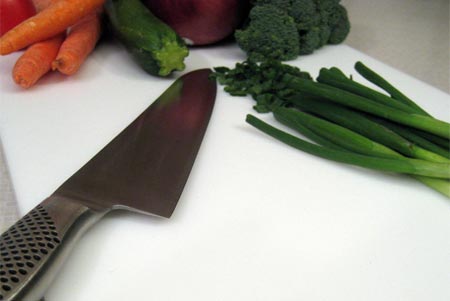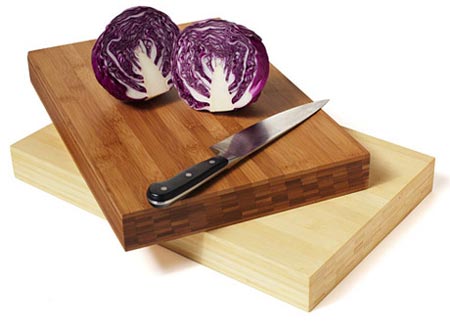Are plastic cutting boards better than wood?
Although plastic cutting boards have been recommended as the safer option, based on the observation that it not as hard to clean plastic as porous wood, new information shows that wood cutting boards are actually safer than the plastic or so-called anti-bacterial kind.
About four years ago, it was discovered that it's easier to recover live bacteria from a plastic cutting board than from one made of wood. Through the capillary action of dry wood, germs quickly disappear beneath the surface of the board, leaving the exposed area free of microbes. In contrast, bacteria sit on the hard plastic cutting board surface, ready to attack the next food item.
Also, hand scrubbing with hot water and soap can clear microbes from the surface of new or used wooden cutting boards and new plastic ones, but knife-scared plastic boards are resistant to decontamination by hand washing.
This does not mean that you can trust wood cutting boards to completely decontaminate themselves or that plastic ones are worthless.
Caution must be taken when using any type of cutting board. Here are some safety tips to keep in mind:
All cutting boards should be scrubbed thoroughly with hot water and soap or if possible run through the dishwasher to insure that they are not contaminated.
Cutting boards, and other food surfaces, should be kept dry when not in use. Resident bacteria survive no more than a few hours without moisture.
-
A mild bleach solution will decontaminate plastic and other surfaces. But even at full strength, bleach does not sanitize wood cutting boards. The disinfectant quality of bleach is neutralized by the organic composition of wood. A good procedure for disinfecting both wood and plastic cutting boards, as well as other surfaces and utensils, is to spray them first with a mist of vinegar, then with a mist of hydrogen peroxide. This combo kills bacteria on meat and produce as well without harming the food.
Cooking a wood board at high heat in an 800-watt microwave oven for ten minutes will kill germs on and below the surface of the wood. Microwaving does not, however, disinfect plastic boards since their surfaces never get hot enough to kill the germs.
Regarding Anti-bacterial Cutting Boards - Save your money
They are not self-sanitizing. Last year, for instance, the US Environmental Protection Agency ordered two companies to stop selling cutting boards that carried labels claiming they prevented the growth of food poisoning organisms, including salmonella and E.coli and reduced the danger of bacterial contamination. These cutting boards had been treated by a pesticide that protects products from odour-causing bacteria however this agent has not been shown to be effective against organisms that can cause disease. Anti-bacterial cutting board concerns are part of a larger EPA crackdown on so-called self-disinfecting brushes, sponges and toys. For now, beware of all anti-bacterial kitchen products.
Note: 81 million cases of food-borne illnesses occur in the US each year, and most of these gut-wrenching infections can be traced to the home kitchen. Any surface, even stainless steel pans, knives, sinks, food-processor blades, and mixing bowls can harbour nasty microbes. Fortunately, kitchen germs can usually be killed by a good scrubbing with hot water and soap, or a turn in the dishwasher, and by keeping all surfaces clean and dry.
source oomph organic


